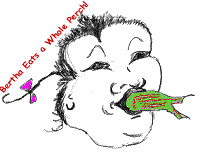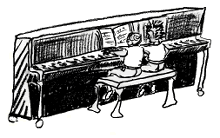|
A
lot of the time in real life situations do not have just one
possible answer, but a range of reasonable answers.
For
example:
Bertha is trying to lose weight by a very strict regime of
exercise and calorie intake management. Her diet guru has
told her that every day she may ingest a maximum of 1400 calories
each day,
but only from various fish and cheese products.

If
Bertha ate a whole perch for breakfast, at a value of 400
calories, how many calories might she eat for the rest of
the day and stay within her 1400 calorie limit?
SOLUTION:
Algebraically Bertha's situation looks like this:
 . .
(This can be solved
by subtracting 400
from both sides of the inequality)
Now some of you may say that the answer is 1000 calories.
However that is just ONE of the possible answers, and it
happens to be the largest one. She could also eat 50 more,
or 10 more, or 999 more, or maybe even NO MORE. You see,
there are a lot of answers that will work here, so we use
math symbols to make it easy to describe the range of possible
answers.
Mathematically
we need to express that she might eat any number of calories
from 0 to 1,000 inclusive.
(Note: the word inclusive means that the statement includes
the endpoints of 0 and 1,000.)
The
math looks like this, assuming that 'c' is the number of
calories Bertha might eat:

(Note:
negative values for 'c' do not make sense in this example)
You
may read this as, "c is greater than or equal to
1 and less than or equal to 1,000,"
or
you may read it as,
"1 is less than or equal to 'c' and 'c' is less than
or equal to 1,000."
_______________
If
you want a picture of this situation, draw a number line
stretching from 0 to 1,000. Since 0 and 1,000 are included
in this range, we place solid dots on the minimum (0) calories
and maximum (1,000) calories, and then we shade all the
rest of the calories in between.

**************************
So
how do we read these funky symbols and what to they really
mean? Look at the chart below.
|
symbols
|
what
the symbols mean
|
|
|
'a'
is less than 'b' |
|
|
'a'
is less than or equal to 'b' |
|
|
'a'
is greater than 'b' |
|
|
'a'
is greater than or equal to 'b' |
|
|
'a'
is less than 'b' and 'b' is less than 'c' |
|
|
'a'
is less than or equal to 'b' and 'b' is less than or equal
to 'c' |
|
|
'a'
is not equal to 'b' |
**************************
Let's
look at another example:
Keri is a newly
certified music teacher. She is starting a music studio in
her hometown of Cornseed Iowa. She must earn MORE than $170
each week to cover her expenses.

If she has some
cute little students from the Cornseed Elementary school who
pay her a total of $75 each week, how much more can she earn
and keep her studio open?
SOLUTION:
If we let the variable 'e' represent the amount Keri can
earn, algebraically, Keri's situation looks like this:
$75
+ e > $170,
(This can be solved
by subtracting $75 from both sides of the inequality.)
So
we see that e > $95. This means that Keri must make MORE
than $95 dollars to keep her studio open. The symbol >
means that 95 is NOT one of the answers, but any amount
of money GREATER than $95, like $95.01, would work.
The
way we show this range of answers graphically is with an
OPEN DOT on a number line and a shaded arrow head.

|

![]()
![]()
